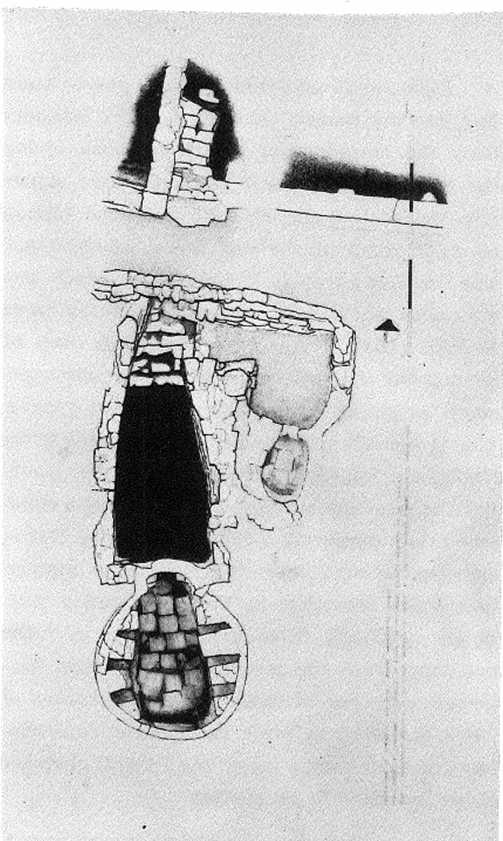1923244569
been discovered at Petra, no attempt was madę to locate a potter’s workshop on the site. It was only by accident that a kiln was discovered in November 1979 when a new road, connecting the Resthouse area with the new housing pro-ject of the Bdul in Dhra‘ Umm es-Sahun to the north of the Petra Basin, was being built. The road was diverted and a rescue campaign was initiated by the Inspector of Petra, Mr. Nabił el Qadi and continued later by the writer. Work is still in progress.

Fig. 6. Petra - Potter’s Kiln
The first season exposed two kilns: the main kiln, which is oval in shape, averages 2.95m in diameter and its gabled entrance is preserved to a height of 1.80m. The fire box is constructed of brick and its dome was supported b> four arches (Fig. 6 and PI. XCVIII, 1). A storage passageway, about 1.15m. wide and built with field stones, extends to the north of the kiln and is approached by a flight of six steps.
To the east of the main kiln is a smaller one, about 0.90m in diameter and preserved to about 0.75m in height.
North of the kilns, a complex of three rooms was uncovered. The main hall, constructed of field stones, was roofed by means of three transverse arches and measures 2.15m by 6m. It was accessible by a flight óf six steps and coated with a thick gray plaster. Many wasters were uncovered on the floor, of the same type of pottery alieady collected in the kilns. It is most probable* that these buildings belong to the potter’s workshop.
From the large amount of ash and brick in the area, it is elear that we have found the industrial area of Gaia (Wadi Musa) and Petra. From the coins and the large amount of pottery lamps and vessels, it is evident that the last phase of the complex dates to the Late Roman and Early Byzantine periods, characterised by coarse pottery painted with black motifs on an orange background. However in one sąuare (6) a large amount of fine Nabataean of the early lst century A. D. ware was collected. As yet we have not found a kiln dating to the Nabataean period but the pottery finds suggest that there was a kiln of this period in the vicinity.
— 351 —
Wyszukiwarka
Podobne podstrony:
419 (10) 392 Dress Accessories cases, though it is likely to have been present. Brass mount no. 935
73emissions18 No express warranties as to Volkswagen vehicies sold in the United States are madę eit
73emissions18 No express warranties as to Volkswagen vehicies sold in the United States are madę eit
Jarosław Bagnicki, Monika Mika Summary In the paper the attempt is madę to estimate the volume of th
htdctmw 034 NO A/££0 TO, JOHNNY. I FOLLOWED ITALL-ON THE SCANM£#, Pay particular attention to
CITY OF NOWY SĄCZ Nowy Sącz was founded on 8 November 1292 by the Bohemian king Wenceslaus II, on th
img004 4 At a limę when rock was evolving further and further away from the forces that had madę the
IMG 140228�01 E S S A Y Garrison KeillorWalking Down the Canyon AS A CHILD, I WAS MADĘ TO LOOK OUT T
key02 : 8 f) If I had been good at Maths, I would have studied it at university. g
Spanish ?yond the?sics BookBackCover Spanish: Beyond the Basia was designed by the experts at Liv
m145 Map 2: First battle of St. Albans, 22 May 1455 hours while reconciliation was attempted, York
mb 31 MUSCLE BUILDING. 31 was being madę by the model. Illustrations Nos. 5 and 7 show the triceps o
i iContact tracing has been applied at different levels across the EU5. Germany implemented a rigoro
img 252 "Heavens!" says the yampire. " You must have worked all your life to acquire
IMGR86 APPENDIX D unknown. A smali fragment of identfcal materiał ejthibited at Madrid in 1955 was f
więcej podobnych podstron